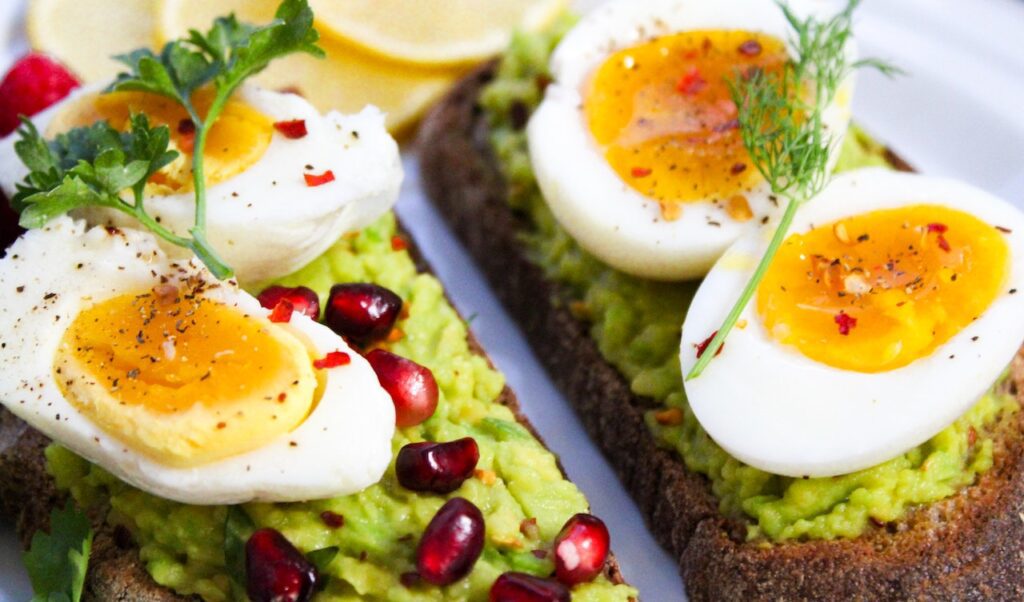
Breakfast is classically called the most important meal of the day as it sets us up, giving us the energy and nutrients we need to do well. It’s particularly important for seniors – helping to lower the risk of nutrient deficiencies and improve their health.
That’s why we’re focusing on healthy breakfast ideas for seniors.
But, we’re not just talking about any breakfasts. We’re looking at ones that are actually interesting and tasty.
We’re also including some unexpected items in the list. After all, traditional breakfast foods are already very familiar and they can get pretty boring.
Switching to more unusual foods can make breakfast much more enjoyable. Your family member might even be more willing to eat.
Our Favorite Healthy Breakfast Ideas for Seniors
Oats with Fresh Berries and Nut Butter
Oatmeal is a popular and familiar breakfast. It’s fairly healthy, as it provides plenty of whole grains and even helps to decrease cholesterol levels.
Serving oatmeal with fresh berries and some nut butter is particularly powerful. The berries add antioxidants and fiber, while the nut butter provides some much needed protein.
If you’re not keen on nut butter, try using some chopped nuts instead or perhaps some seeds. Using an ingredient like this really is an important feature, as oatmeal ends up being too carb heavy otherwise.
Mix Up Oats
If regular oatmeal gets boring, why not try another approach?
Overnight oats are one option. These involve soaking the oats in liquid overnight, which makes them soft without the need for any cooking. It’s easy to add flavoring ingredients and make the oatmeal taste simply amazing.
Once the oats have soaked, they can be served cold, at room temperature, or slightly warmed.
Then there’s baked oatmeal. This may be more familiar to seniors and is often delicious. It can easily be prepared in advance and even frozen, ready to be microwaved when it’s time for breakfast.
Greek Yogurt with Berries
We can’t go past Greek yogurt. It’s packed with all the nutrients you find in regular yogurt, but is also much higher in protein. The protein makes it much more satisfying so that seniors will stay full for longer.
Adding some berries provides some fiber and makes the yogurt taste even better. You could even add some healthy granola as well, to make a full meal out of it.
Yogurt is particularly good for seniors who don’t feel like breakfast, as it’s easy to eat and often seems like a treat.
To get the most benefits, look for plain Greek yogurt (the flavored versions often contain too much sugar and additives). You can always mix in some sweetener or flavoring ingredients to make the yogurt taste better.
Eggs (in any form)
We can’t go past eggs. They’re incredibly nutritious and packed with protein. That protein makes them filling, so an egg or two can often keep seniors going for hours.
That’s not all. Eggs are also practical, as they can be cooked quickly and are often soft (making them perfect for seniors with no teeth). You can serve them in plenty of ways too. Omelets, poached eggs, scrambled eggs, and egg muffins are just a few useful approaches.
What about cholesterol? Eggs are still sometimes seen as unhealthy or bad for your heart because of their cholesterol content.
However, most of the time the cholesterol isn’t a big issue (our bodies produce cholesterol on their own anyway). Unless the senior’s doctor says otherwise, eggs are likely to offer many more benefits than risks.
Avocado Toast
Avocado toast has received some flack as a millennial dish, which is a pity, as it’s actually a delicious and healthy breakfast dish.
After all, you’re getting plenty of nutrients and healthy fats from the avocados, plus some nutrients from the bread. Whole grain or sprouted bread is the best approach, as this is less processed and healthier than plain white bread.
Breakfast Casseroles
Breakfast casseroles are fantastic. Not only can they be very healthy, but you’re also preparing a decent amount at once.
To make this work, though, you need to choose the recipe carefully. After all, many breakfast casseroles are loaded with calories and ingredients like cheese, soup, and even cream.
Thankfully, there are plenty of healthy options too, including these breakfast casseroles. Why not try a few of them out for yourself?
Savory Oatmeal Bowls
Oatmeal is normally served with sweet toppings, but this isn’t your only option. You can also make savory oatmeal, using toppings like spinach, tomatoes, mushrooms, and eggs.
Cottage Cheese With Fresh Fruit
Want something simple for breakfast? Try a bowl of cottage cheese with some fresh berries on top.
The cottage cheese is creamy and provides plenty of protein, while the berries are packed with flavor and provide an excellent contrast.
Chia Seed Pudding
Chia seed puddings became popular fairly recently, so many seniors won’t be familiar with them. Don’t let that stop you though, as chia puddings are an excellent breakfast choice.
At their simplest, chia puddings are made by soaking chia seeds in some type of liquid. The seeds absorb water and become gelatinous, which gives the dish a pudding-like texture.
You can easily make the dish more interesting by adding ingredients for flavor, like cocoa powder, berries, or perhaps peanut butter. As long as you keep the sugar content low, chia seed puddings are actually very healthy – providing seniors with plenty of protein and fiber.
Breakfast Burritos
Breakfast burritos aren’t always a wise choice, as they’re often high in calories and saturated fat. However, you can make healthy versions without too much effort. Plus, breakfast burritos can often be prepped ahead of time and frozen – ready to be heated in the microwave when breakfast is needed.
To create a healthy version, you simply need to keep an eye on the ingredients. Make sure there are plenty of plant-based ingredients in there, such as beans, avocado, peppers, spinach, and tomatoes.
Also be cautious of ingredients like sausage, bacon, and cheese. Because these are high in saturated fat, it’s best to use small amounts of these or avoid them entirely.
Chickpea Pancakes
Regular pancakes taste amazing, but they don’t have much else going for them – especially if you’re serving them with sweet toppings.
Chickpea pancakes are different. Because they’re made using chickpea flour, they’re a decent source of fiber and protein. You can easily serve them with traditional sweet toppings or switch things up and make a savory breakfast instead.
Protein Bowls
We talked about savory oatmeal earlier, but you can actually do the same type of thing with other carb rich ingredients as well.
Most protein bowls follow this idea. You start off with a carb as the base, like couscous, quinoa, orzo, or rice, then start stacking healthy ingredients on top. These ingredients are often high in protein (hence the name), but you can also include plenty of vegetables too.
The style is wonderful because it’s so easy to customize. You can add and remove ingredients as you see fit.
Any Healthy Meal
Breakfast can get pretty boring if you only rely on traditional breakfast foods. So, why do that? You can easily mix things up.
It’s often best to focus on the foods that the senior can easily eat and match their appetite.
What this looks like will depend on the individual. For example, some aging parents might turn to a light open faced sandwich, while others may prefer something heartier, perhaps even a stew or leftovers from last night’s dinner.
In fact, leftovers are often the ideal choice, as they just need to be reheated and are often very nutritious.
A Delicious Salad
What about salad for breakfast? This style can be perfect for seniors who don’t have much appetite first thing in the morning. It also allows them to avoid heavy and greasy meals.
The pictured salad is an exceptional example, as it offers plenty of protein from the walnuts and quinoa, plus some complex carbs from the sweet potatoes and nutrients from the greens. It also has a fantastic balance of flavors and textures.
Protein Smoothies
Smoothies for breakfast isn’t just a weight loss thing. The idea is also a great way for seniors to get nutrients and protein when they don’t really want to eat.
You can buy premade smoothies (including those from Boost and Ensure), but it’s much better to make your own. Protein powder is an easy source of protein or you can branch out and use ingredients like Greek yogurt, silken tofu, cottage cheese, or nut butter.
Why Do Seniors Need Breakfast?
Good nutrition is important at any age, as nutrients keep our bodies functioning well.
When we’re younger, skipping breakfast every so often isn’t a huge deal. Some people even miss it every day and eat larger meals at other times.
But, skipping breakfast can easily lead to nutrient deficiencies, which puts health at risk. This issue is particularly relevant for seniors, as many experience decreases in appetite, making it more difficult for them to eat as much as they need to.
Plus, our ability to absorb nutrients tends to decrease with age. This places seniors at an even higher risk of nutrient deficiencies.
Finally, breakfast is an important part of the senior’s daily routine. A sense of rhythm and routine can make a huge difference for some seniors.
Breakfasts To Be Cautious With
Finally, let’s talk a little about the breakfasts that aren’t so great. These may be okay every so often, but certainly shouldn’t be a daily indulgence.
- White toast with jelly. This breakfast is packed with carbs and sugar, but doesn’t provide much protein or many nutrients. Whole grain toast is better, especially if you use a protein-packed spread.
- Processed cereal and granola. While there are some healthy brands out there, many cereals are packed with sugar and have a pretty shocking nutritional profile. If you’re going to serve cereal, look for high protein products that have been minimally processed.
- Instant oatmeal. The additives and sugar in instant oatmeal make it an unhealthy choice that isn’t very filling.
- Pancakes. Regular pancakes tend to be high in carbs and offer little protein. Plus, they’re often served with sugary or high fat toppings, like cream and syrup. The same is true for waffles.
- Muffins. Muffins often seem like a decent breakfast choice, especially if they contain bran. However, most muffins are more like cakes than breakfast foods. And, like cakes, they are often high in calories and won’t keep you full.
- Breakfast pastries. Not surprisingly, breakfast pastries aren’t great either. This includes products like Pop-Tarts, along with freshly made pastries. Most of the time you’re looking at a high calorie, high fat, and low protein product that’s made with refined flour.
- Smoothies. While smoothies and protein shakes can be helpful and healthy, it’s easy to create unhealthy versions instead, ones that are very high in sugar. So, if you’re making smoothies, pay close attention to the recipe and make sure there’s a good balance of protein to sugar.


Leave a Reply